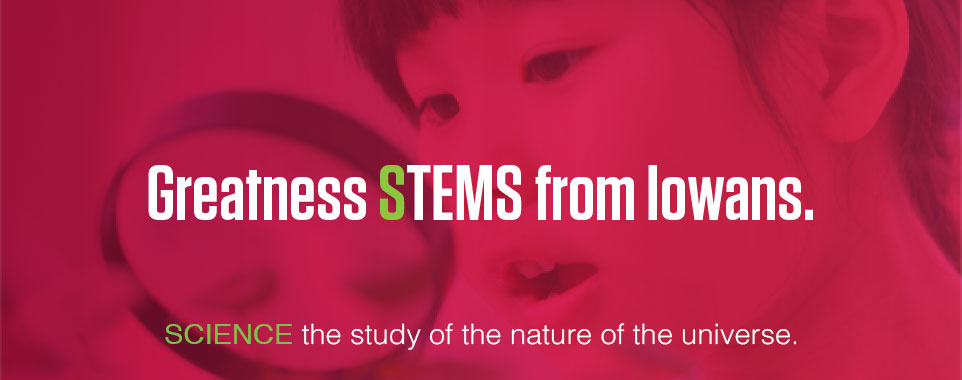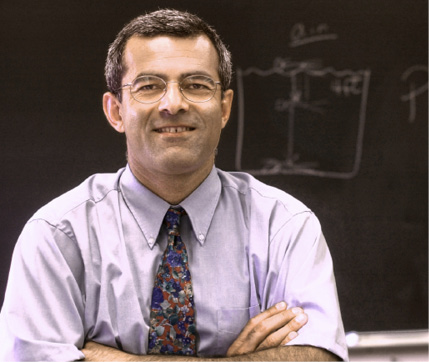You can’t swing a stick without hitting a STEM hub these days. There is a lot of excitement around Science, Technology, Engineering and Math, otherwise known as STEM. STEM education is seen as critical; governors are promoting it; legislators are funding it. There is an air of discovery: new understandings that are coming to us from outer space, from the Mars rovers, and the frontiers of science are being pushed back. There is a feeling that somehow life will be better as a result of more math and science.
But when math and science produce knowledge useful to living in Iowa, or that is vital to our health or our survival on the planet, too often we totally ignore it. The real message this sends to aspiring scientists is: Go ahead; do your math and science, but if you discover something that goes contrary to the vested corporate interests, we will ignore it. Don’t expect we will do anything with that knowledge.
In higher education, “discovery” and new knowledge are prized, but they are considered to be “scholarly.” Actually implementing and putting into widespread practice what we already know, what we have invested lots of time and resources to learn, is just not valued.
• • •
Right after the flood of 2008 hit Iowa, I received a call from Mr. Don Palmer of Cedar Rapids, who was very eager to do something that would make the Cedar River basin hold more rain water upstream, and release it more slowly. He knew that I, as a council member of the flooded city, was concerned about the role land use could play in reducing flood damage. We immediately connected and met a few days later. He discussed engineering strategies, and I shared what I knew about landscape remedies in which more water could be stored in the soil profile. We discussed all sorts of ways Iowa could be a more secure and resilient state in the face of future floods.
I was amazed to learn that Mr. Palmer was a retired engineer from the aerospace engineering firm Rockwell Collins–the very man whose team had developed the radio communication devices for the Apollo’s first Moon landing 40-some years before. We both joked that it was ironic that four decades after the Moon landing, we still had not figured out how to live in Iowa without causing damage, as was evidenced by degraded watersheds that couldn’t handle downpours, and by all the houses that were built on floodplains.
The frontiers of science are right here, where we live.
Knowledge derived from science concerning floodplains is ancient, and can be vital to our wellbeing in Iowa, if we take it seriously. Currently cities allow building in the floodplain as long as you build at least one foot above the 100-year flood elevation. This is in spite of what we learned from the flood of 2008, after which a committee of Iowa’s brightest water resources and hydrology experts suggested to the legislators to make the 500-year flood elevation the rule. This would have given more room to the rivers, and matched our experiences with recent reality. However, this became one more instance—one among many—of the best science being ignored by local and state government. Actions speak louder than words: however much we might want to appear to be serious about STEM and what it tells us, our decisions say something else entirely: we are not serious about math and science.
There are other indicators of this lack of STEM seriousness. For instance, scientific evidence has been piling up over recent decades which shows that the current system of corn-bean commodity crop agriculture has not served Iowa well, and is in fact causing soil erosion, water pollution, loss of habitat and biodiversity, and public health hazards due to massive use of pesticides and large scale animal confinement operations, not to mention rural decline. STEM educators ought to respond to these facts by presenting legislators with curricula and testimonies that address our need for answers to these problems, rather than continuing to support policies which, it is clear, only deepen them.
Now, here is some good news from the STEM sector: long-term studies by Matt Liebman and colleagues at Iowa State University have demonstrated that diversifying the simple corn-bean cropping system can have a huge positive impact on Iowa. According to the ISU researchers, compared to conventional corn-bean rotation:
- Diverse rotations require 88 percent fewer herbicides, resulting in 200 times less freshwater toxicity.
- Diverse crop rotations require 80 percent less synthetic nitrogen.
- Diverse rotations require 50 percent less energy per acre.
- Diverse crop rotations have significantly fewer soybean diseases.
- And, diverse crop rotations have higher yields.
This is what writer and environmental activist Wendell Berry calls “solving for pattern”—meaning an elegant solution that solves multiple problems. Research has been tending in this direction for decades, but these recent scientific results are even more compelling. What would happen if these cropping systems were incentivized in the watershed that provides the drinking water for the city of Des Moines? With findings such as these coming from our state’s land-grant universities, one can’t help but wonder why STEM-supporting legislators and our STEM-boosting governor are silent concerning such findings.
Nowhere is the disregard for the research findings which STEM delivers to us more visible than in PK-12 public schools, where, ironically, it ought to be thriving. Here, the research clearly calls for sound early childhood development, as well as developmental programs which carry on all the way through the teenage years and into adulthood. However well-intentioned our schools might seem to be in this area, rhetorically, once again practice tells us a different story. Nearly all of our public schools routinely use pesticides that have a demonstrated record of interfering with hormonal and nervous systems in children, causing life-long learning and cognitive disabilities (you need only Google “pesticides & children” to see what I mean). Despite the abundantly available scientific evidence which indicates this is bad practice, our science-touting school officials nearly always insist that it is important to have the school ground dandelion-free, no matter what.
Similar concerns can be registered as regards the meals our schools are serving to schoolchildren. With very few exceptions, all public schools continue to serve fatty, salty, highly processed meals, as if our educational decision-makers are ignorant concerning widely published, extensively vetted good-sense guidelines concerning what constitutes a healthy meal. There is often a long list of excuses as to why a school district cannot feed children as the research shows they ought to. Once again, this ignorance concerning available scientific evidence would seem to indicate that good nutrition is just not a priority in our allegedly STEM-promoting schools.
• • •
Similarly, our STEM-boosting educators, legislators and governor are failing the state of Iowa in another category, this one concerning the evidence coming from atmospheric sciences.
The same science which fuels the spirit of “discovery,” which has enabled advanced heart surgery, which was behind the development of the polio vaccine and the prescription for your glasses, which made it possible to build the safe buildings you work in; the same science which led to NASA’s successful program of Mars landings; the same rigorous science which has ensured that math, physics, chemistry and biology continue to produce reliable results—has indicated that our burning of fossil energy is negatively impacting the chemistry of the oceans, and the stability of the atmosphere that supports all life, and our economy.
And what do STEM-supporting legislators, STEM educators and STEM-touting university scientists have to say in response? Too often, their only response is a big silence.
It really is hard to take our policy-makers’ rhetoric about the importance of STEM seriously when so much of what we already know—not to mention the new findings which continue to flow from the laboratories and offices of university and government—is routinely ignored, on a daily basis, on matters vital to the preservation of our health, our land, and our economy.
This is why science historian Naomie Oreskes, in her new book The Collapse of Western Civilization: A View from the Future, calls this time of disregard for science “the second Dark Age,” where “the children of the Enlightenment failed to act on robust information about climate change and knowledge of damaging events… even those involving imminent threats.”
I say to young scientists, STEM hub managers, and university scientists: it does not have to be this way. As biologist Sandra Steingraber puts it, we too often confuse objectivity with neutrality. Of course it is necessary to practice objectivity in the process of science. But when science produces compelling data vital to the future of the planet, we are morally obligated not to be neutral. There is a lot we do not know, and a lot which we need to learn; but there is a vast amount we know which we ignore. We must insist on putting into practice that which we already know.
It should be a primary task of STEM educators, legislators, and all citizens to use the data which science produces to move from “know-how” to “do-now.” Otherwise, what is science for? We need to be out there at press conferences with our white lab coats, with our agronomy field clothes, declaring what we know, and engaging others in developing strategies to implement it.
• • •
In her introduction to Into the Field: A Guide to Locally Focused Teaching, naturalist Ann Zwinger writes “Getting to know home is the most human and necessary of occupations. To give the power of observation to students is to give them something of infinite value and importance—something to do for the rest of their lives.”
This is what some have called “place-based education”—education that is connected to a place; education that will turn out citizens with deep appreciation of their region and a good sense of how to care for it. This is the context in which STEM education should be situated: producing citizens who understand the impact of their habits on other people and other lands, near and far. It’s what Wes Jackson calls a Homecoming education.
A couple of years ago, about 70 people from all over Iowa gathered at Iowa State Senator Dotzler’s home in Waterloo, from which we floated down the Cedar River for a few hours in our canoes and kayaks, to celebrate the treasures of this watershed and to reaffirm our commitment to its protection. It was a beautiful day, pelicans with nine-foot wingspans flew by; kingfishers were active, and a bald eagle posed for us on a nearby tree.
While this was a thoroughly terrestrial experience, I can also say that the frontiers of space exploration were—and are—right here with us. We’ve spent billions funding Mars landings and searching for water on the Red Planet, while we have water here, and an urgent need to protect it. Science has produced results we can and should put to practice in our region, today.
There is so much to do here, so much to pay attention to, so many mistakes to correct, so many legacies to appreciate which have come down to us from the generations who came before; so many streams to restore, so many neighborhoods to revitalize, so many ways to show our children and the world that it possible both to care for a region by leading sustainable and responsible lives.


